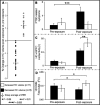Stress-induced reduction in hippocampal volume and connectivity with the ventromedial prefrontal cortex are related to maladaptive responses to stressful military service
- PMID: 22807242
- PMCID: PMC6870265
- DOI: 10.1002/hbm.22100
Stress-induced reduction in hippocampal volume and connectivity with the ventromedial prefrontal cortex are related to maladaptive responses to stressful military service
Abstract
Previous studies have shown that people who develop psychopathology such as posttraumatic stress disorder (PTSD) following stress exposure are characterized by reduced hippocampal (HC) volume and impaired HC functional connectivity with the ventromedial prefrontal cortex (vmPFC). Nevertheless, the exact interrelationship between reduced HC volume and HC-vmPFC connectivity deficits in the context of stress has yet to be established. Furthermore, it is still not clear whether such neural abnormalities are stress induced or precursors for vulnerability. In this study, we combined measurements of MRI, functional MRI (fMRI), and diffusion tensor imaging (DTI) to prospectively study 33 a priori healthy Israeli soldiers both pre- and post-exposure to stress during their military service. Thus, we were able to assess the contributions of structural and functional features of the HC and its connectivity to the onset and progression of maladaptive response to stress (i.e., increased PTSD symptoms post-exposure). We found that soldiers with decreased HC volume following military service (i.e., post-exposure) displayed more PTSD-related symptoms post-exposure as well as reduced HC-vmPFC functional and structural connectivity post-exposure, compared to soldiers with increased HC volume following military service. In contrast, initial smaller HC volume pre-exposure did not have an effect on any of these factors. Our results therefore suggest that reduction in HC volume and connectivity with the vmPFC together mark a maladaptive response to stressful military service. As stress-induced HC volume reductions were previously shown to be reversible, these localized biological markers may carry valuable therapeutic potential.
Keywords: DTI; MRI; PTSD; fMRI; functional connectivity; structural connectivity; uncinate fasciculus; volumetry.
Copyright © 2012 Wiley Periodicals, Inc.
Figures


References
-
- Admon R, Lubin G, Rosenblatt JD, Stern O, Kahn I, Assaf M, Hendler T (2012): Imbalanced neural responsivity to risk and reward indicates stress vulnerability in humans. Cereb Cortex. Epub ahead of print. - PubMed
-
- Blechert J, Michael T, Vriends N, Margraf J, Wilhelm FH (2007): Fear conditioning in posttraumatic stress disorder: Evidence for delayed extinction of autonomic, experiential, and behavioural responses. Behav Res Ther 45:2019–2033. - PubMed
-
- Brambilla P, Barale F, Caverzasi E, Soares JC (2002): Anatomical MRI findings in mood and anxiety disorders. Epidemiol Psichiatr Soc 11:88–99. - PubMed
-
- Bremner JD, Scott TM, Delaney RC, Southwick SM, Mason JW, Johnson DR, Innis RB, McCarthy G, Charney DS (1993): Deficits in short‐term memory in posttraumatic stress disorder. Am J Psychiatry 150:1015–1019. - PubMed
Publication types
MeSH terms
Substances
LinkOut - more resources
Full Text Sources
Other Literature Sources
Medical
Research Materials

